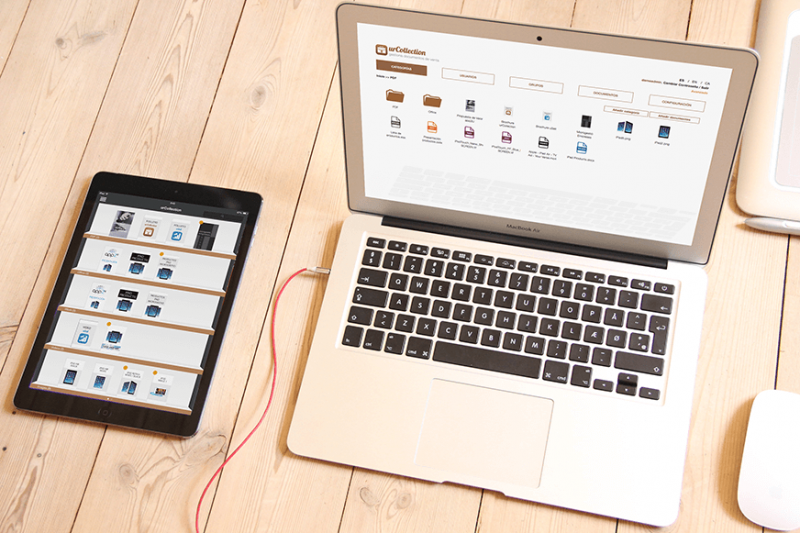Once you will have all the files well classified in the administration panel and your sales force will have a user account, it means you will be ready to start using urCollection.
What do you need in order to use the document manager?
In order that your sales force can see the documents in the mobile devices’ screens, they must follow the next steps:
1. Download urCollection app in their tablets from AppStore, Android or Windows
2. Enter their username and password to log in. This information has been sent to their personal email
*If you are a user with administrator roles, you can also use the app on your mobile device by following the same steps.
How to download the files on the devices?
The downloading of shared files on your tablet is done automatically when the user accesses for the first time in our sales software. Still, it is possible that this first time the documents take more time to download according to the connection speed you have. You can update the files downloading whenever you want from the menu by clicking the Synchronize button. This way, you make sure that all the documents are updated.
urCollection’s advanced options
urCollection offers several advanced options to speed up the documents searching process inside the app. The two first are located in the Menu tab inside the Configuration section:
1. Views of the shared documents
Views are the way in which documents are shown in your tablet’s screen. From the administration panel you can choose how your sales force will see the shared documents inside urCollection; though you have also the option of allowing them to choose how they want to see the files. There are two types of document views:
Shelves view: The documents of this document management program are shown as if it was a library. Each shelf belongs to one of the categories that you have set up from the administration portal. This view is useful for companies that work with few documents and want to show them to the customer in a sophisticated way
List view: In this one, categories and documents are shown in a list format. This view is useful for companies that work with a lot of documents, because it speeds the searching up
2. Documents’ name
In the Shelves View there is an option of showing or not the documents’ name. You can define this option from the administration web panel. You can also allow the sales force to choose if they want to see the name so that they can identify the file better, or if they prefer not to see it because they recognize them just by looking at the cover.
3. Document searching
If you can’t find a document, you can also look for it by writing its name –or its folder’s name- at the browser located in the upper-right side of the app.
How to know which permissions and related documents a document has?
Depending on the selected documents’ view, the permissions and the related documents will be seen in one place or another:
If you have selected the Shelves View: Press softly the file you want with your finger, then a new screen with the Permissions and Related Documents will appear
If you have selected the List View: Pay attention to the icons appearing on the right of each document to see the permissions that this document has. Furthermore, you will find another icon with a stacked-files shape that shows the Related Documents
New documents in urCollection
If as an administrator you modify or add some document, the sales force should just synchronize their devices in order to receive the updates. When they do it, a yellow icon will appear on the upper-left side telling them that there are new files available on the document manager. To access faster the new documents, select the New Documents tab on the left menu. Once the new document is checked, this will stop being new and the yellow icon will disappear.
Menu’s Categories / Folders
To speed up the searching of documents, or just because you want to show one single folder to your customers, you can filter the Categories by selecting them one by one inside the left main Menu.
Logout
There are workers who use their tablets both in a work environment and a personal one; also known as BYOD (Bring your own device). To ensure company’s documents protection, each user can log out from their devices and this way avoid that the information remains visible for all who can access the tablet. Thus, you make sure that if the sales force has not protected his/her device and has lost it, nobody who finds it could have access to the company’s documentation because this worker will have log out urCollection protecting this way the content.






Leave A Comment